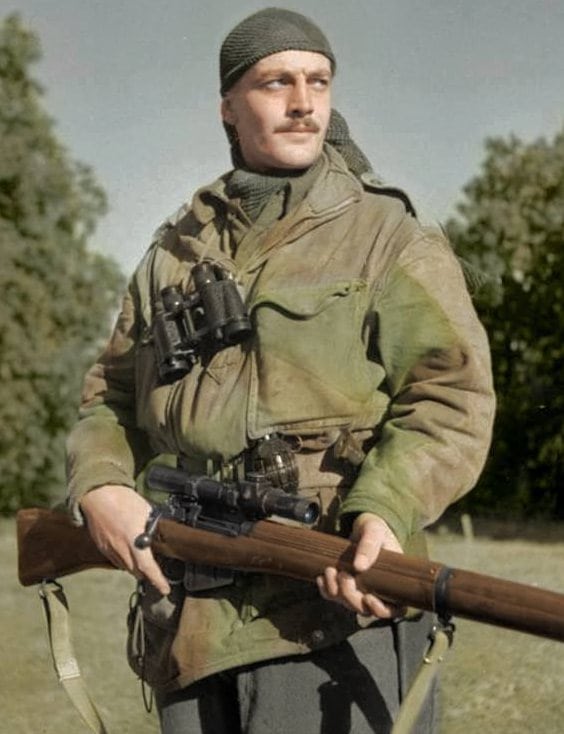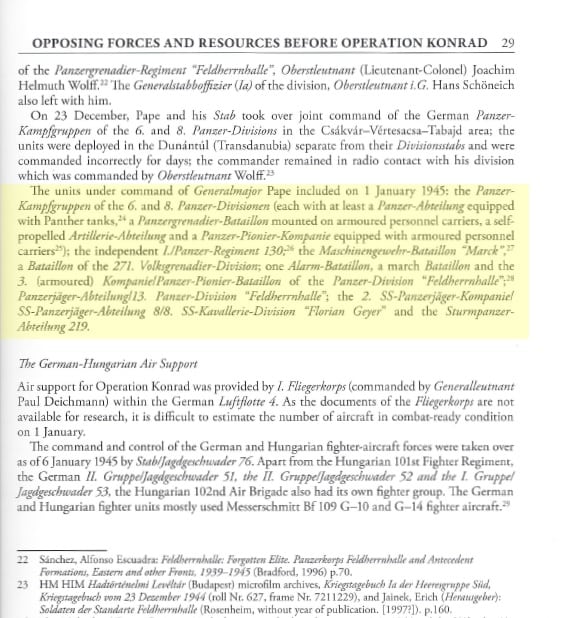Researching an Order of Battle – Getting Started
Part 1 - Introduction
Hi, I'm Mike Avanzini. Now that we have shown you how we design a wargame, I wanted to share how we research our Order of Battles in more depth. I plan to publish a range of blog posts that covers off my learnings for each nationality and the various resources available. I'll show examples of typical orders of battle for the main nationalities along with documenting the books, documents and online sites used.
In starting to research an order of battle for a Panzer Battles or Panzer Campaigns game we usually like to start with a definitive book on the subject. We are fortunate to be living in a time when there are quite a number of well researched and well written books on the battles of World War Two. Authors like David Glantz, David, Stahel, Jason Marks, Stephan Hamilton, and Norbert Számvéber to name a few, are writing very detailed operational histories of battles on the eastern and western fronts. Many of these books contain divisional level order of battles you can use as a starting point.
To be able to create an order of battle down to company and platoon level you will need accurate TO&E information (Tables of Organization and Equipment), along with other reference data. While there are many online sites where some of this information is available, I find it very useful to have a lot of this data at my fingertips in a reference library.
Since 2001 I have collected well over 200 books just pertaining to unit TO&E and unit composition for most armies in World War Two. This includes American, British, German, Soviet, Italian, Japanese, French, Romanian and Hungarian along with a few lesser known armies. Included in this collection is a large quantity of German KStN’s, and we have purchased from a friend of mine in Moscow over 1,000 Soviet Shtat’s for the Great Patriotic War (both of these are the designations for TO&E within those armies).
Since David “Strela” and I teamed up a few years back we have added quite a number of German, Russian and Italian language books and documents to our extensive library. These included many books located in the Soviet/Russian archives and purchases through my aforementioned Russian friend.
Over the years David and I have collected quite a bit of primary source material digitally. We have over 550 gigs worth of data, (close to 300 rolls), from the German Archive Records at NARA, the US National Archives, along with a few 100 gigs of primary Soviet documents from Tsamo, the Russian archives.
Part 2A – The Germans
In approaching an order of battle for a game title, we start to collect as much data as we can find. Most of the time we like to start with a well-researched book on our topic choice as our main source. Let’s look at a hypothetical game on the battles near Budapest in January 1945.
A recently published volume, “The Sword Behind the Shield”, by Norbert Számvéber is a very good operational history covering the three Konrad battle of January 1945.
Although the book contains some OOB detail, we usually like to get our information from the archival records for accuracy. Having no good Army or Corps record documents for this period, we used a schematic from the OKH records (Pub T78) for the complete Army dated 31.12.45 which goes down to division level, see portion below showing Army Group South.
For the purposes of our example, we are going to concentrate on building one formation - the 6. Panzer-Division. This division was split into two groups, with the main division north of the Danube and a kampfrgruppe (KG) taking part in Operation Konrad 1. In the schematic we can see that the main part of 6. Panzer is under the command of LXXII.AOK, which is under Gr. Kirchner, “6.Pz (o gep Tie)”. The “o” is for ohne meaning without, the term gep is for gepanzert meaning armored, while the Tie is for Tiele meaning a part or portion. So we can read this as 6.Pz-Div without the armored part.
We also see that part of the 6. Panzer is under the command of Gr. Pape and it is the armored part of the division, “gep tie. 6.Pz”.
The second chapter of “The Sword Behind the Shield” covers the opposing forces and resources before the start of the operation. On page 29 (see above) we see that Gruppe Pape (commanded by Generalmajor Pape) took over command of the kampfgruppen of the 6. and 8. Panzer-divisions. It also has a breakdown of the kampfgruppen along with the other units comprising Gruppe Pape. In the schematic on the preceding page you can see that Gruppe Pape is under the command of Gruppe Breith (III. PzK), along with the divisional assets of the gruppe.
We can see in the highlighted section that the kampfgruppen contained a panzer-abt equipped with Panther tanks, an armored panzer-grenadier btl, the self-propelled artillery-abt and a company of armored pioniers. This is a great start to building the 6. Panzer-Division and placing it under the correct command structure
To get a better picture of the 6. Panzer and maybe a better breakdown of the kampfgruppe we use another book on the late war panzer divisions, “Fire Brigades” by Kamen Nevenkin.
This fantastic book covers the Army and Waffen SS Panzer Divisons from the spring of 1943 to the end of the war. Each division is covered with a combat history, organization, strengths, monthly delivery of armor and monthly condition reports all taken from the German Archival Records. This is one of those must have books for building armored units from the Kursk period until the end of the war.
On page 198 of the book we find the 6. Panzer-Division in December of 1944:
|
On 13 December the first units of 6. Pz.Div. arrived in Gyor (Raab). It was intended that the division participate in a German counteroffensive against the Soviet troops deployed south of the Hungarian capital (Operation "Spätlese”). However, on 18 December the enemy launched a powerful attack near Ipoyszog (northeast of Esztergom). The planned offensive was cancelled and the division was transferred to the northern bank of the Danube. However, only the main body of 6. Pz.Div. was sent to Ipolyszog. One Pz. Kpf Gr. (Stab/Pz.Rgt. 11, I/Pz.Rgt. 11, I/Pz.Rgt. 26, fl. (gep )/Pz. Gren.Rgt. 114, I(Sf)/Pz.Art.Rgt. 76) remained on the southern bank of the Danube. Thus the division was divided into two parts. However, this situation was not favorable for either of them - the Panzergrenadiers missed the firepower of the armor, while the armored units were short of infantry support. This separation was a grave mistake of the German High Command, because by mid-December 6. Pz.Div. was in very good condition. It was rested and well replenished with both personnel and materiel. It may safely be said that the offensive capability of the division was used in the worst possible way. On 20 December the enemy launched a full-scale offensive against the German-Hungarian positions between lakes Balaton and Velence ("Margarethen" Line). On 20/21 December Pz.Kpf.Gr. 6. Pz.Div. was assembled near Lovasbereny (north of Lake Velence). It took part in counterattacks against the enemy in this area, but achieved no results. On 22 December it was assigned to Gruppe "Pape" - an ad-hoc blocking formation, which was commanded by the Operations Staff of Pz.Div. "Feldherrnhalle". On 23 December Stab/Pz.Rgt. 1 of 1. Pz.Div. was assigned to Gruppe "Pape". lt was used to command Pz.Kpf.Gr./6. Pz.Div. and thus Kpf.Gr. "Philipp" was formed. By the end of December the battle group was in defense west of the Hungarian capital. Meanwhile, on 20 December the Soviets mounted a major offensive on the northern bank of the Danube. They attacked from Ipolyszog to the northwest. On 21 December the division (deprived of the vital support of its Pz.Kpf.Gr.) took part in a counteroffensive and counterattacked the southern flank of the enemy. During the following day the Soviet troops were encircled northwest of lpolyszog. However, the left flank of the attacking German forces remained uncovered and on 25 December the Soviets mounted a counteroffensive. On 26 December the German grouping (including 6. Pz.Div.) was encircled north of Esztergom. On the next day it began to break out. By 29 December the division managed to cross the River Hron and by 31 December occupied positions on its western bank. From 21 December Pz.Aufk.Abt. 6 was detached from 6. Pz.Div. Until the beginning of January it was in action near Kalna and Hronom (Nagy-Kalna (northeast of Nove Zamky). On 24 December the division reported the following strength: 34 Pz. IV (24 operational), 56 Pz. V (49), 2 Befl.Pz. IV (1), 6 Befl.Pz. V (6) 8 FlakPz. IV (3), 16 Pz.]g. IV (14), 6 Pz.Beob. IV (5), 93 leSPW (87), 128 mSPW (112), 5 lePz.Sp. Wg. (4), 19 sPz.Sp. Wg. (18), 13 sPak (mot Z), 5 leFH (Sfl 1(4), 13 leFH (mot Z), 13 sFH (Sfl) (12), 8 sFH (mot Z) and 5 10.5-cm sK (mot Z). Furthermore, I/Pz.Rgt. 26 had 30 Pz. V (26), 2 Befl.Pz. V (2), 1 leSPW (0) and 2 mSPW (2). |
We see in the second paragraph that there is a Pz.Kpf.Gr formed from the armored elements of 6. Pz-Div. The units in the kampfgruppe consisted of:
Stab/Pz.Rgt.11, (or the HQ of Pz-Regt.11).
I./Pz.Rgt.11 (this is the Panther battalion)
I./Pz.Rgt.26 (this was an independent Panther battalion that eventually became part of the Panzer-Division Brandenburg
II./(gep)/Pz-Gren-rgt.114 (this is the armored infantry battalion of the division)
I./(sf)/Pz.Art.Rgt.76 (this is the self-propelled artillery battalion (Wespe’s and Hummel’s)
Further down the page we see that the kampfgruppe was assigned to Gr. Pape on December 23, and was put under the command of Stab/Panzer-Rgt 1, 1. Panzer Division, and was also named Kr.Gr. Philipp after the commander of Pz-Rgt 1.
And at the bottom of the page we have a strength report dated 24 December 1944.
On the next page we find information on the battles the 6. Panzer Division in January 1945.
|
1 January 1945 - February 1945: Relief Attacks Towards Budapest. On 1 January 1945 the Germans launched their first attempt to relieve the encircled garrison of Budapest ( Operation ''Konrad I").Initially only Pz.KpfGr. of 6. Pz.Div. took part in this attack. It was still under the command of Stab/Pz.Rgt. 1 (Kpf.Gr. "Philipp"). Kpf.Gr. "Philipp" was the spearhead of Gruppe “Pape”, which attacked from an area north of Tatabanya to the East. It reached Tarjan and on 3 January was redirected to the south west towards Felsögalla. By 5 January its attack was halted. On 3 January began the transfer of the main body of the division from the northern bank of the Danube to the south. By 6 January it was assembled near Tatabanya and Pz.Kpf.Gr. rejoined its parent division there. From 6 January 6. Pz.Div. mounted an attack from near Tatabanya in the direction of Bicske (west of Budapest). However, the enemy offered vigorous resistance and on 8 January ''Konrad I" was suspended. On 6 January the Soviets mounted a surprising powerful attack against the Axis positions on northern bank of Danube in the direction of Komarno. Pz.Aufk.Abt. 6, which had been separated from its parent division since 21 December, was engaged in heavy combat. Its actions contributed to the halting of the enemy offensive. The battalion rejoined 6. Pz-Div during the second half of January. On 9 January the Germans launched their second attempt to relieve the encircled garrison of Budapest ( Operation ''Konrad II"). The division continued to fight near Bicske. ''Konrad II" achieved very limited results also and on 12 January was suspended. On 15 January 6. Pz.Div. reported the following strength: 3,523 men, 23 Pz. IV (8 operational), 46 Pz. V (20), 1 Befl.Pz. IV (0), 4 Befl.Pz. V (2), 7 FlakPz. IV (4), 18 Pz.]g. IV (5), 4 Pz.Beob. IV (2), 84 leSPW (67), 115 mSPW(83), 5 lePz.Sp. Wg. (3), 19 sPz.Sp. Wg. (16), 16 sPak (mot Z), 4 leFH (Sfl) (4), 12 leFH (mot Z), 10 sFH (sfl) (8), 8 sFH (mot Z) and 410.5-cm sK (Mot Z). Moreover, I/Pz.Rgt. 26 had 28 Pz. V(ll), 1 Befl.Pz. V (1), 1 leSPW (0), and 2 mSPW (1). On 15 January an order was issued to detach I./Pz.Rgt. 26 from the division and assign it to Panzergrenadier-Division "Brandenburg". It was to leave all of its panzers behind in Hungary. On 18 January 1945 the Germans launched their third attempt to relieve the besieged garrison (Operation ''Konrad III"). 6. Pz.Div. was not used in the first stage of this offensive. On 24 and 25 January it launched an unsuccessful attack near Felsögalla (east ofTatabanya). Meanwhile one Pz.Kpf.Gr. (elements of Pz.Rgt. 11 and II./(gep)/Pz.Gren.Rgt. 114) was detached from the division. On 26 January it took part in an attack near Zamoly (north of Szekesfehervar)as part of 4. Kavallerie Brigade. On 26 January an order was issued to transfer 4./Pz.Aufk.Abt. 6 from Germany to H.Gr. "Sud" to rejoin its parent division. 199 |
We find out that on 1 January 1945 the Germans launched Operation Konrad I, the first relief attack towards Budapest. It tells us that Kr.Gr. Philpp was the spearhead of Gruppe “Pape” and areas of the attack. This is all information we pull out and file away towards a possible scenario covering a part of Operation Konrad I.
On 3 January the main part of 6. Panzer-Division was transferred south and by the 6th the Kr.Gr. was joined with the rest of the division. The Division then participated in an attack toward Bicske, and then on 8 January the operation was cancelled. We also see that the Pz-Aufk-Abt 6 was still detached from the division and fighting north of the Danube but rejoined the division by the middle of the month.
On 9 January 1945 Operation Konrad II launched but after limited results it was cancelled 3 days later on the 12th.
We then see a strength report dated 15 January which also includes manpower. We also learn that I./Pz-Rgt 26 was ordered to detach and was assigned to the Panzer-Davison “Brandenburg” leaving its panzers behind in Hungary.
And at the bottom of the page we see the divisions participation in Operation Konrad III which continues on the next page.
As you can see we have now collected quite a bit of hard information on the 6. Panzer-Division and we can start work on the OOB for this division. In the next blog we will look at delving into the German Archival records for some hard data.










Very informative. Thank you for sharing.
Leave a comment